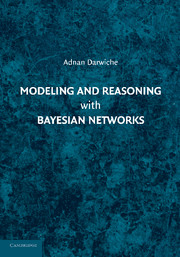Refine listing
Actions for selected content:
1372 results in Ebooks on robotics
Introduction
- from PART II - THE IMPORTANCE OF MACHINE ETHICS
-
- Book:
- Machine Ethics
- Published online:
- 01 June 2011
- Print publication:
- 09 May 2011, pp 47-50
-
- Chapter
- Export citation
7 - Machine Ethics and the Idea of a More-Than-Human Moral World
- from PART III - ISSUES CONCERNING MACHINE ETHICS
-
-
- Book:
- Machine Ethics
- Published online:
- 01 June 2011
- Print publication:
- 09 May 2011, pp 115-137
-
- Chapter
- Export citation
27 - A Prima Facie Duty Approach to Machine Ethics
- from PART IV - APPROACHES TO MACHINE ETHICS
-
-
- Book:
- Machine Ethics
- Published online:
- 01 June 2011
- Print publication:
- 09 May 2011, pp 476-492
-
- Chapter
- Export citation

Modeling and Reasoning with Bayesian Networks
-
- Published online:
- 23 February 2011
- Print publication:
- 06 April 2009
20 - Theory of Distributions
-
- Book:
- Advanced Mathematics for Applications
- Published online:
- 05 June 2012
- Print publication:
- 06 January 2011, pp 568-619
-
- Chapter
- Export citation
Part I - Applications
-
- Book:
- Advanced Mathematics for Applications
- Published online:
- 05 June 2012
- Print publication:
- 06 January 2011, pp 51-52
-
- Chapter
- Export citation
List of tables
-
- Book:
- Advanced Mathematics for Applications
- Published online:
- 05 June 2012
- Print publication:
- 06 January 2011, pp xvii-xviii
-
- Chapter
- Export citation
1 - The Classical Field Equations
-
- Book:
- Advanced Mathematics for Applications
- Published online:
- 05 June 2012
- Print publication:
- 06 January 2011, pp 3-26
-
- Chapter
- Export citation
15 - Green's Functions: Ordinary Differential Equations
-
- Book:
- Advanced Mathematics for Applications
- Published online:
- 05 June 2012
- Print publication:
- 06 January 2011, pp 348-399
-
- Chapter
- Export citation
Contents
-
- Book:
- Advanced Mathematics for Applications
- Published online:
- 05 June 2012
- Print publication:
- 06 January 2011, pp vii-xii
-
- Chapter
- Export citation
7 - Spherical Systems
-
- Book:
- Advanced Mathematics for Applications
- Published online:
- 05 June 2012
- Print publication:
- 06 January 2011, pp 170-212
-
- Chapter
- Export citation
Part 0 - General Remarks and Basic Concepts
-
- Book:
- Advanced Mathematics for Applications
- Published online:
- 05 June 2012
- Print publication:
- 06 January 2011, pp 1-2
-
- Chapter
- Export citation
Part III - Some Advanced Tools
-
- Book:
- Advanced Mathematics for Applications
- Published online:
- 05 June 2012
- Print publication:
- 06 January 2011, pp 535-536
-
- Chapter
- Export citation
3 - Fourier Series: Applications
-
- Book:
- Advanced Mathematics for Applications
- Published online:
- 05 June 2012
- Print publication:
- 06 January 2011, pp 53-83
-
- Chapter
- Export citation
Part II - Essential Tools
-
- Book:
- Advanced Mathematics for Applications
- Published online:
- 05 June 2012
- Print publication:
- 06 January 2011, pp 213-214
-
- Chapter
- Export citation
10 - The Fourier and Hankel Transforms
-
- Book:
- Advanced Mathematics for Applications
- Published online:
- 05 June 2012
- Print publication:
- 06 January 2011, pp 266-284
-
- Chapter
- Export citation
16 - Green's Functions: Partial Differential Equations
-
- Book:
- Advanced Mathematics for Applications
- Published online:
- 05 June 2012
- Print publication:
- 06 January 2011, pp 400-417
-
- Chapter
- Export citation
6 - Cylindrical Systems
-
- Book:
- Advanced Mathematics for Applications
- Published online:
- 05 June 2012
- Print publication:
- 06 January 2011, pp 146-169
-
- Chapter
- Export citation
11 - The Laplace Transform
-
- Book:
- Advanced Mathematics for Applications
- Published online:
- 05 June 2012
- Print publication:
- 06 January 2011, pp 285-301
-
- Chapter
- Export citation
2 - Some Simple Preliminaries
-
- Book:
- Advanced Mathematics for Applications
- Published online:
- 05 June 2012
- Print publication:
- 06 January 2011, pp 27-50
-
- Chapter
- Export citation
